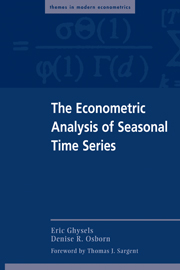Book contents
- Frontmatter
- Contents
- Foreword by Thomas J. Sargent
- Preface
- List of Symbols and Notations
- 1 Introduction to Seasonal Processes
- 2 Deterministic Seasonality
- 3 Seasonal Unit Root Processes
- 4 Seasonal Adjustment Programs
- 5 Estimation and Hypothesis Testing with Unfiltered and Filtered Data
- 6 Periodic Processes
- 7 Some Nonlinear Seasonal Models
- Epilogue
- Bibliography
- Subject Index
- Author Index
6 - Periodic Processes
Published online by Cambridge University Press: 05 June 2012
- Frontmatter
- Contents
- Foreword by Thomas J. Sargent
- Preface
- List of Symbols and Notations
- 1 Introduction to Seasonal Processes
- 2 Deterministic Seasonality
- 3 Seasonal Unit Root Processes
- 4 Seasonal Adjustment Programs
- 5 Estimation and Hypothesis Testing with Unfiltered and Filtered Data
- 6 Periodic Processes
- 7 Some Nonlinear Seasonal Models
- Epilogue
- Bibliography
- Subject Index
- Author Index
Summary
Introduction
As discussed in Chapter 1, periodic processes are processes in which the coefficients change with the seasons of the year. A deterministic seasonal process, in which the intercept changes seasonally, can be viewed as a special case of a periodic process. However, allowing other parameters to vary seasonally opens up a rich class of models that have been found to be useful as descriptions of economic variables; applications include Birchenhall et al. (1989), Flores and Novales (1997), Franses and Romijn (1993), Herwartz (1997), and Osborn and Smith (1989).
These processes have not been very widely applied in economics to date. Certainly their applications are fewer than those of either deterministic seasonality or nonstationary stochastic seasonality, with little analysis of the implications of seasonal adjustment for periodic processes. This explains why we examine periodic processes after other topics have been dealt with in some detail. Nevertheless, a number of studies show that periodic processes can arise naturally from the application of economic theory to modeling decisions in an economic context, and their role should not be dismissed as unimportant. For example, Gersovitz and MacKinnon (1978) and Osborn (1988) argue that a process of this type arises when modeling the seasonal decisions of consumers, while Hansen and Sargent (1993) suggest that it could also arise from seasonal technology. Once it is admitted that the underlying economic driving forces such as preferences or technologies may vary seasonally, then subtle periodic seasonal effects may come into play even in contexts generally considered to be nonseasonal.
- Type
- Chapter
- Information
- The Econometric Analysis of Seasonal Time Series , pp. 139 - 181Publisher: Cambridge University PressPrint publication year: 2001

